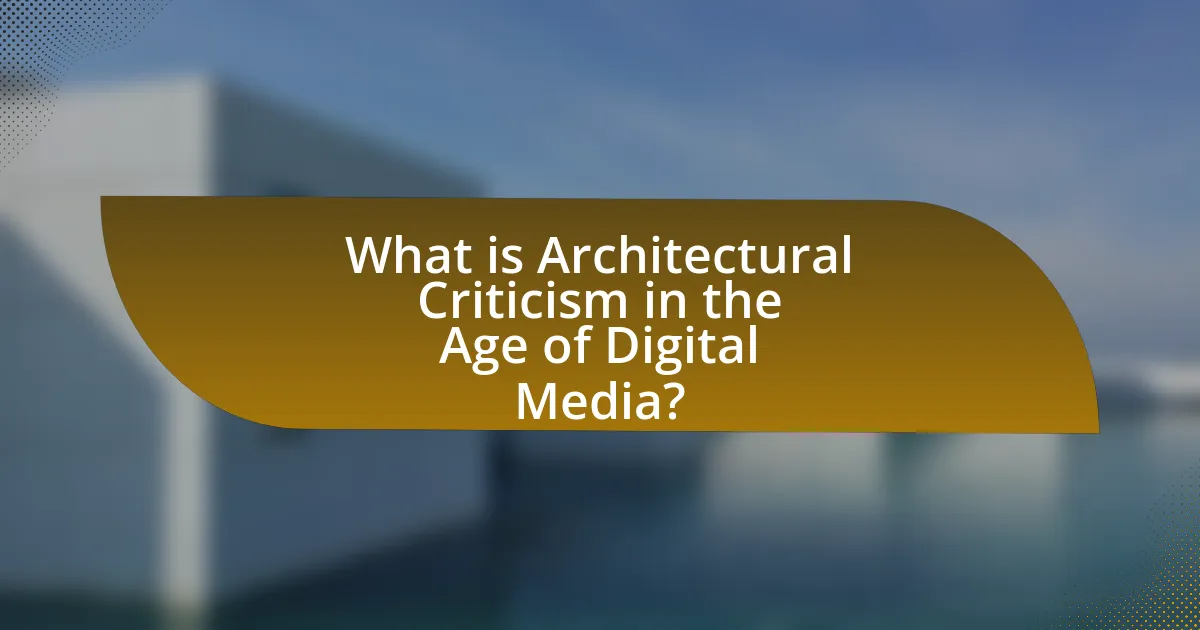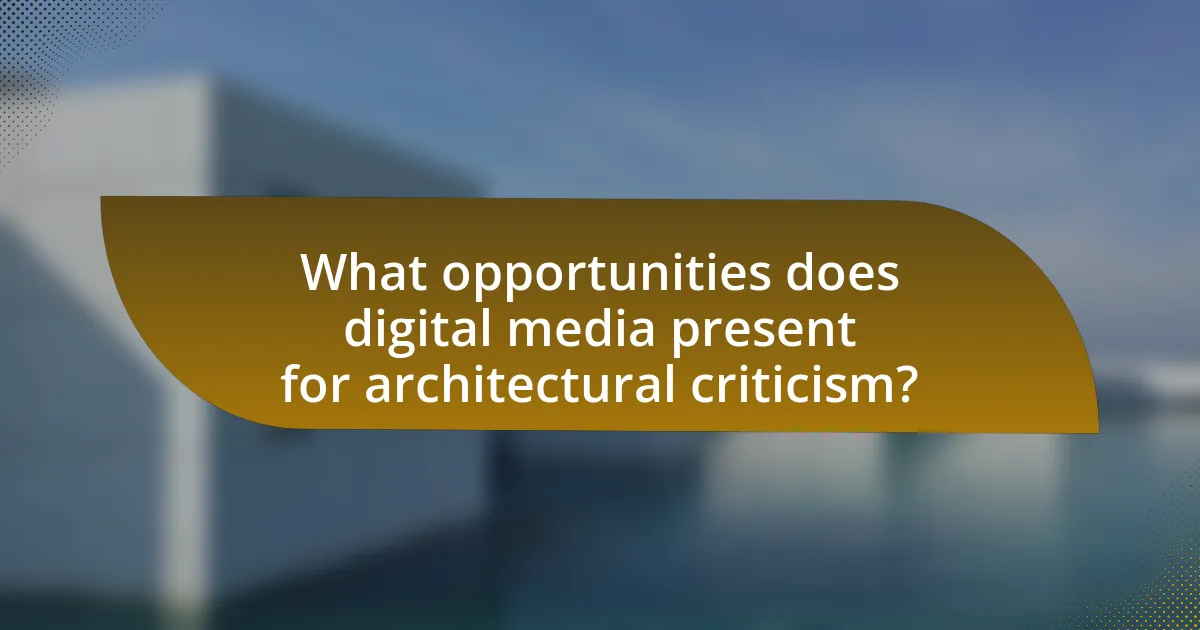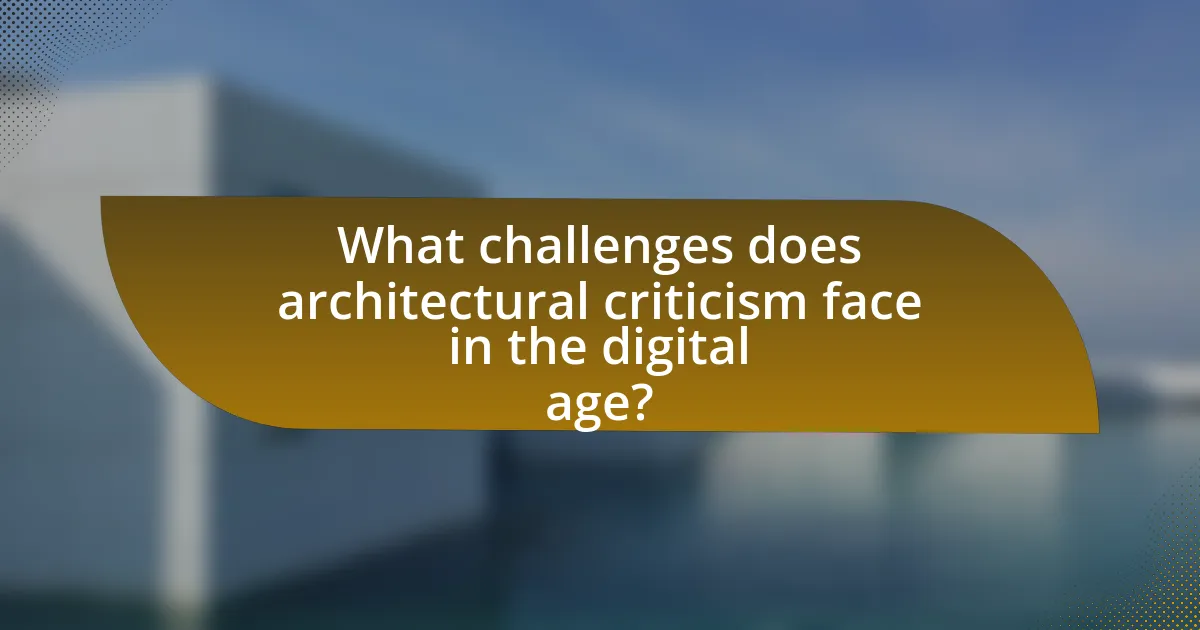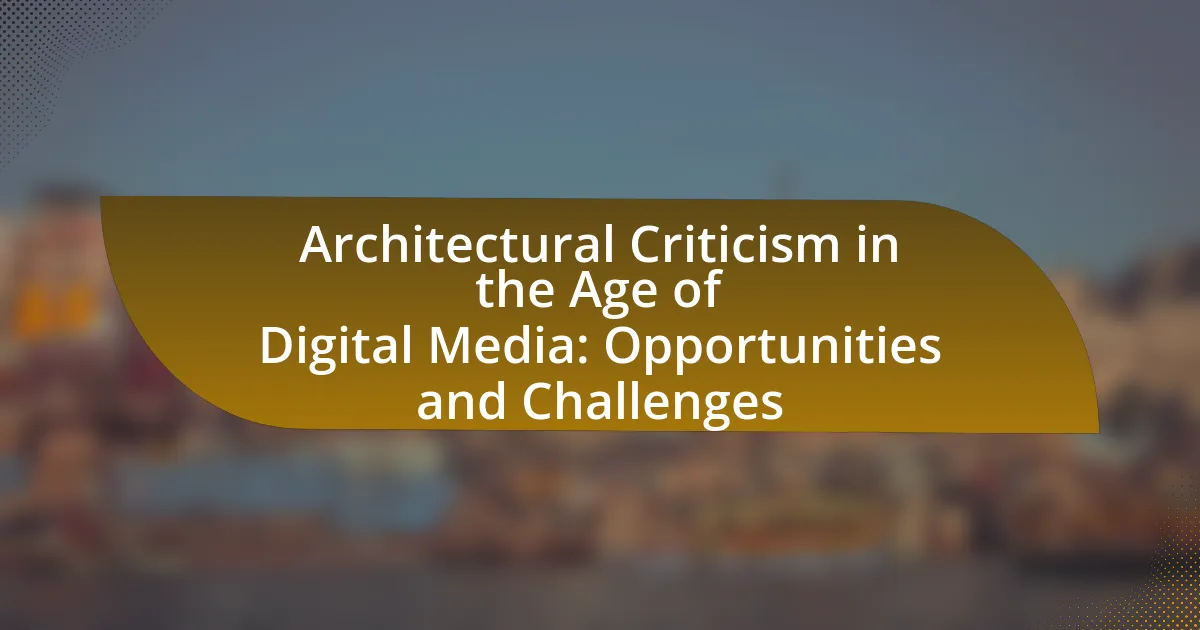Architectural criticism in the age of digital media encompasses the evaluation and analysis of architectural works through various digital platforms, enhancing accessibility and engagement. This article explores how digital media has transformed architectural criticism by enabling immediate dissemination of critiques, fostering interactive discussions, and democratizing the discourse. Key digital platforms influencing this transformation include social media, online publications, and collaborative design tools, which shape public perception and facilitate diverse voices in architectural discussions. The article also addresses the challenges posed by misinformation, the need for credible criticism, and ethical considerations in the digital landscape, while highlighting best practices to enhance architectural criticism in this evolving context.

What is Architectural Criticism in the Age of Digital Media?
Architectural criticism in the age of digital media refers to the evaluation and analysis of architectural works through digital platforms and tools, which significantly enhance accessibility and engagement. Digital media allows critics to disseminate their insights widely, utilizing blogs, social media, and online publications, thus reaching a broader audience than traditional print media. This shift has transformed the landscape of architectural discourse, enabling real-time feedback and interaction between critics, architects, and the public, while also presenting challenges such as the potential for superficial analysis and the rapid spread of misinformation.
How has digital media transformed architectural criticism?
Digital media has transformed architectural criticism by enabling immediate dissemination and broader accessibility of critiques. This shift allows critics to share their insights through various platforms, such as blogs, social media, and online publications, reaching a global audience instantly. For instance, the rise of platforms like Instagram and Twitter has facilitated visual storytelling, allowing critics to showcase architectural works alongside their commentary, thus enhancing engagement. Additionally, digital media fosters interactive discussions, enabling real-time feedback and dialogue between critics, architects, and the public, which was less feasible in traditional print formats. This transformation has democratized architectural criticism, allowing diverse voices to contribute to the discourse, thereby enriching the field.
What are the key digital platforms influencing architectural discourse?
Key digital platforms influencing architectural discourse include social media networks, online publications, and collaborative design tools. Social media platforms like Instagram and Pinterest allow architects to showcase their work visually, fostering engagement and dialogue within the community. Online publications such as ArchDaily and Dezeen provide critical analysis and news, shaping public perception and discourse around architecture. Collaborative design tools like BIM 360 and SketchUp facilitate real-time collaboration among architects, clients, and stakeholders, enhancing communication and innovation in architectural practices. These platforms collectively transform how architectural ideas are shared, critiqued, and developed in the digital age.
How do social media and blogs shape public perception of architecture?
Social media and blogs significantly shape public perception of architecture by providing platforms for immediate and widespread dissemination of architectural ideas, images, and critiques. These digital channels allow architects, critics, and the general public to share their views and experiences, influencing how architecture is perceived and valued. For instance, platforms like Instagram and Pinterest enable users to visualize architectural designs and trends, often leading to viral popularity for certain styles or projects. Research indicates that user-generated content on these platforms can lead to increased public engagement and interest in architecture, as seen in the rise of participatory design discussions online. This democratization of architectural discourse allows diverse voices to contribute, ultimately shaping collective opinions and preferences regarding architectural aesthetics and functionality.
What are the historical contexts of architectural criticism?
Architectural criticism has evolved through various historical contexts, reflecting changes in society, technology, and aesthetics. Initially, during the Renaissance, architectural criticism emerged as a formal discipline, with figures like Leon Battista Alberti advocating for the principles of beauty and proportion in architecture. In the 18th and 19th centuries, the Industrial Revolution introduced new materials and construction techniques, prompting critics to address the implications of modernity on architectural design, as seen in the writings of John Ruskin and Viollet-le-Duc. The 20th century saw the rise of movements such as Modernism, which challenged traditional forms and emphasized functionality, leading critics like Reyner Banham to explore the relationship between architecture and technology. Each of these contexts shaped the discourse around architecture, influencing how critics assess and interpret built environments.
How did traditional architectural criticism evolve before digital media?
Traditional architectural criticism evolved through several key phases, beginning with the Renaissance, where critics like Vitruvius emphasized the importance of proportion and aesthetics. In the 18th and 19th centuries, architectural criticism became more formalized with the establishment of journals and publications, such as “The Architectural Review,” which provided a platform for critiques and discussions on design and urbanism. The 20th century saw the rise of influential critics like Lewis Mumford and Robert Venturi, who challenged modernist principles and introduced diverse perspectives on architecture’s social and cultural implications. This evolution was marked by a shift from purely aesthetic evaluations to a broader discourse that included historical context, functionality, and user experience, reflecting changing societal values and technological advancements in construction.
What role did print media play in shaping architectural criticism?
Print media played a crucial role in shaping architectural criticism by providing a platform for the dissemination of ideas, analysis, and discourse surrounding architecture. Historically, publications such as Architectural Record and The Architectural Review have influenced public perception and professional standards by featuring critiques, essays, and reviews that assess architectural works and trends. These print outlets established a formalized space for architects, critics, and scholars to engage in dialogue, thereby elevating the discourse around design and its cultural implications. The impact of print media is evident in how it has historically set benchmarks for quality and innovation in architecture, guiding both practitioners and the public in understanding the significance of built environments.

What opportunities does digital media present for architectural criticism?
Digital media presents significant opportunities for architectural criticism by enhancing accessibility, fostering engagement, and enabling diverse perspectives. The proliferation of online platforms allows critics to reach wider audiences, breaking geographical barriers and democratizing access to architectural discourse. For instance, social media channels like Instagram and Twitter facilitate real-time discussions and visual critiques, allowing critics to share insights and images instantly. Additionally, digital media encourages interactive formats, such as video essays and podcasts, which can engage audiences more deeply than traditional print media. This shift not only broadens the scope of architectural criticism but also invites contributions from a more diverse range of voices, enriching the dialogue surrounding architecture.
How can digital platforms enhance accessibility to architectural criticism?
Digital platforms enhance accessibility to architectural criticism by providing widespread dissemination of content and facilitating diverse engagement. These platforms, such as blogs, social media, and online publications, allow critics to reach global audiences instantly, breaking geographical barriers that traditionally limited access to architectural discourse. For instance, the rise of platforms like Instagram and Twitter has enabled architects and critics to share insights and critiques visually and interactively, attracting a broader demographic. Furthermore, digital platforms often offer multimedia formats, such as videos and podcasts, which cater to different learning preferences and increase audience engagement. This democratization of information allows for a more inclusive dialogue around architecture, as individuals from various backgrounds can contribute their perspectives and experiences, enriching the overall discourse.
What are the benefits of democratizing architectural discourse?
Democratizing architectural discourse enhances inclusivity and broadens perspectives in the field of architecture. By allowing diverse voices to participate, it fosters a richer dialogue that can lead to innovative design solutions and community-oriented projects. Research indicates that inclusive discourse can improve public engagement and satisfaction with architectural outcomes, as seen in participatory design initiatives where community input directly influences project development. This approach not only empowers marginalized groups but also encourages architects to consider a wider array of cultural and social contexts, ultimately leading to more relevant and sustainable architectural practices.
How do online forums and communities contribute to architectural discussions?
Online forums and communities significantly enhance architectural discussions by providing platforms for diverse perspectives and real-time feedback. These digital spaces facilitate the exchange of ideas among architects, students, and enthusiasts, fostering collaborative learning and innovation. For instance, platforms like Archinect and Reddit’s architecture subreddit allow users to share projects, critique designs, and discuss trends, which can lead to improved architectural practices. Research indicates that such interactions can democratize architectural discourse, making it accessible to a broader audience, thus enriching the field with varied insights and critiques.
What innovative formats are emerging in architectural criticism?
Innovative formats emerging in architectural criticism include digital platforms, podcasts, and interactive media. Digital platforms such as blogs and social media allow for immediate feedback and broader audience engagement, while podcasts provide in-depth discussions and interviews with architects and critics, enhancing accessibility. Interactive media, including virtual reality and augmented reality experiences, enable users to engage with architectural spaces in immersive ways, offering a new dimension to criticism. These formats reflect the shift towards more participatory and visually driven critiques, aligning with contemporary digital consumption habits.
How do video essays and podcasts change the way architecture is critiqued?
Video essays and podcasts transform architectural critique by making it more accessible and engaging for a broader audience. These formats allow for visual and auditory storytelling, which can convey complex architectural concepts and critiques in a more digestible manner than traditional written reviews. For instance, video essays can showcase architectural designs through visuals, enabling viewers to understand spatial relationships and aesthetics better. Podcasts, on the other hand, facilitate in-depth discussions and interviews with architects and critics, providing diverse perspectives and insights that enrich the critique process. This shift towards multimedia platforms has democratized architectural criticism, allowing voices from various backgrounds to contribute, thus fostering a more inclusive dialogue about architecture.
What role does virtual reality play in architectural criticism?
Virtual reality plays a transformative role in architectural criticism by enabling immersive experiences that enhance the evaluation of architectural designs. This technology allows critics to engage with spaces in a three-dimensional environment, facilitating a deeper understanding of scale, proportion, and spatial relationships. Studies have shown that virtual reality can improve the communication of architectural concepts, making it easier for critics to articulate their insights and for audiences to grasp complex design ideas. For instance, a 2020 study published in the Journal of Architectural Education highlighted how virtual reality simulations led to more informed critiques by allowing participants to experience designs as if they were physically present, thus bridging the gap between theoretical analysis and experiential understanding.

What challenges does architectural criticism face in the digital age?
Architectural criticism faces several challenges in the digital age, primarily due to the rapid dissemination of information and the rise of social media platforms. The immediacy of online communication often prioritizes speed over depth, leading to superficial analyses that lack the rigor traditionally associated with architectural critique. Additionally, the democratization of content creation allows anyone to share opinions, which can dilute expert voices and create a cacophony of unverified information. This environment complicates the task of distinguishing credible criticism from mere commentary, making it difficult for audiences to navigate the quality of insights available. Furthermore, the visual nature of digital media can overshadow textual analysis, leading to an emphasis on aesthetics rather than substantive critique.
How does the abundance of information affect the quality of architectural criticism?
The abundance of information enhances the quality of architectural criticism by providing critics with a wider range of perspectives and data to analyze. This increased access to diverse sources allows for more informed critiques, as critics can draw on historical context, contemporary trends, and various architectural theories. For instance, the proliferation of digital platforms enables critics to reference a multitude of case studies and architectural practices globally, enriching their evaluations. Furthermore, the availability of real-time feedback from audiences can lead to a more dynamic and responsive form of criticism, as seen in platforms like social media where discussions about architectural works occur instantaneously. This interconnectedness ultimately fosters a more nuanced understanding of architecture, as critics can synthesize information from various disciplines and viewpoints, leading to higher-quality discourse in the field.
What are the risks of misinformation in digital architectural discourse?
Misinformation in digital architectural discourse poses significant risks, including the distortion of public perception, undermining professional credibility, and leading to poor decision-making in design and policy. The spread of inaccurate information can mislead stakeholders, such as clients and policymakers, resulting in misguided investments and ineffective urban planning. For instance, a study by the American Institute of Architects highlights that misinformation can lead to the misallocation of resources, ultimately affecting community development and sustainability. Additionally, misinformation can erode trust in architectural professionals, as clients may question the validity of expert opinions when faced with conflicting narratives online.
How can critics maintain credibility in a saturated media landscape?
Critics can maintain credibility in a saturated media landscape by prioritizing accuracy, transparency, and expertise in their evaluations. Accurate assessments are essential, as they build trust with audiences; for instance, critics who fact-check their claims and provide well-researched insights are more likely to be viewed as reliable sources. Transparency about their methodologies and potential biases further enhances their credibility, allowing audiences to understand the basis of their opinions. Additionally, critics who possess specialized knowledge or experience in architecture can offer unique perspectives that distinguish them from less informed voices, reinforcing their authority in the field. This combination of accuracy, transparency, and expertise is crucial for critics aiming to stand out and maintain credibility amidst the overwhelming volume of information available in today’s media landscape.
What ethical considerations arise in digital architectural criticism?
Ethical considerations in digital architectural criticism include issues of authenticity, representation, and the impact of digital platforms on public perception. Critics must ensure that their evaluations are based on accurate information and not manipulated by digital tools that can distort reality. Furthermore, the accessibility of digital media raises concerns about inclusivity, as marginalized voices may be underrepresented in discussions. The potential for misinformation and the speed at which content spreads also necessitate a responsibility to verify facts before publication. These considerations highlight the need for ethical standards in the evolving landscape of architectural criticism.
How do issues of plagiarism and originality manifest in online criticism?
Issues of plagiarism and originality in online criticism manifest through the unauthorized use of others’ ideas and expressions, leading to ethical concerns and diminished credibility. In the digital landscape, critics often face challenges in maintaining originality due to the vast availability of information and the ease of copying content. Research indicates that approximately 30% of online content may contain some form of plagiarism, highlighting the prevalence of this issue. Furthermore, the anonymity of the internet can encourage individuals to present others’ work as their own, undermining the integrity of architectural criticism. This situation necessitates a heightened awareness of proper citation practices and the importance of developing unique perspectives to foster genuine discourse in the field.
What responsibilities do critics have towards their audience in the digital space?
Critics have the responsibility to provide accurate, informed, and unbiased evaluations of architectural works to their audience in the digital space. This includes conducting thorough research, presenting facts, and offering context to ensure that their critiques are grounded in reality. For instance, critics should reference specific architectural principles or historical precedents when discussing a building’s design, which helps audiences understand the significance of the work. Additionally, critics must engage with their audience by being transparent about their perspectives and potential biases, fostering trust and encouraging informed discussions. This responsibility is crucial in a digital environment where misinformation can spread rapidly, making it essential for critics to uphold standards of integrity and clarity in their assessments.
What best practices can enhance architectural criticism in the digital age?
Best practices that can enhance architectural criticism in the digital age include fostering interdisciplinary collaboration, utilizing diverse digital platforms for dissemination, and engaging with a broader audience through interactive content. Interdisciplinary collaboration allows critics to incorporate insights from fields such as sociology, technology, and environmental science, enriching the analysis of architectural works. Utilizing diverse digital platforms, such as blogs, social media, and podcasts, enables critics to reach wider audiences and adapt their messages to different formats, increasing accessibility and engagement. Engaging with a broader audience through interactive content, such as virtual tours or augmented reality experiences, encourages public participation and feedback, making architectural criticism more relevant and impactful. These practices are supported by the increasing use of digital media in architecture, as evidenced by the rise of online architectural forums and the popularity of social media platforms for sharing architectural insights.
